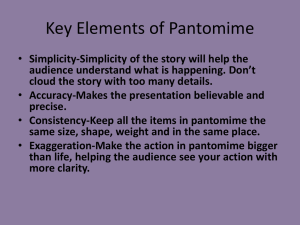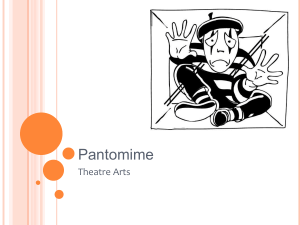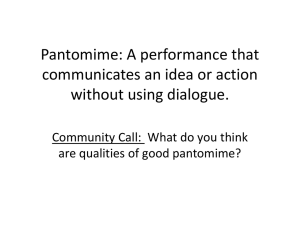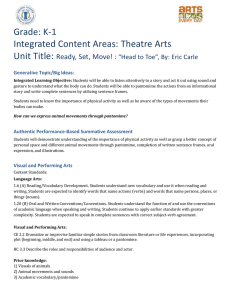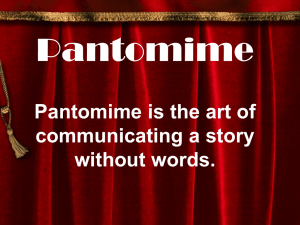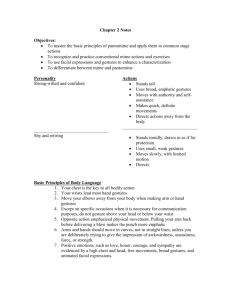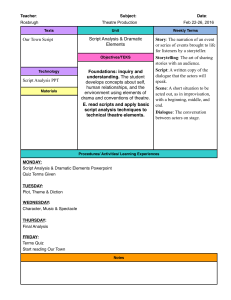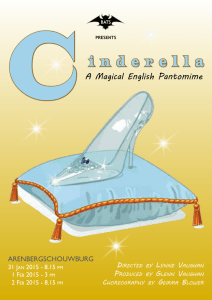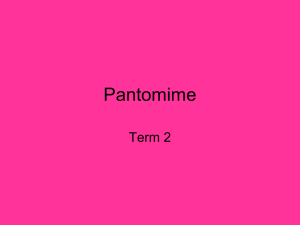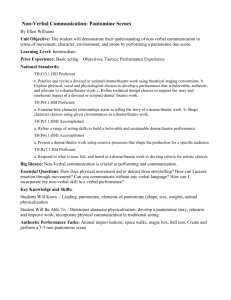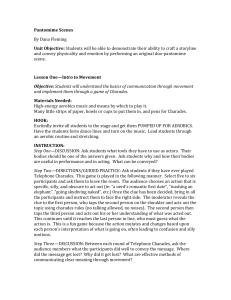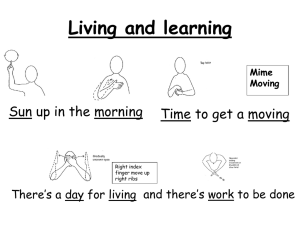Pantomime
advertisement
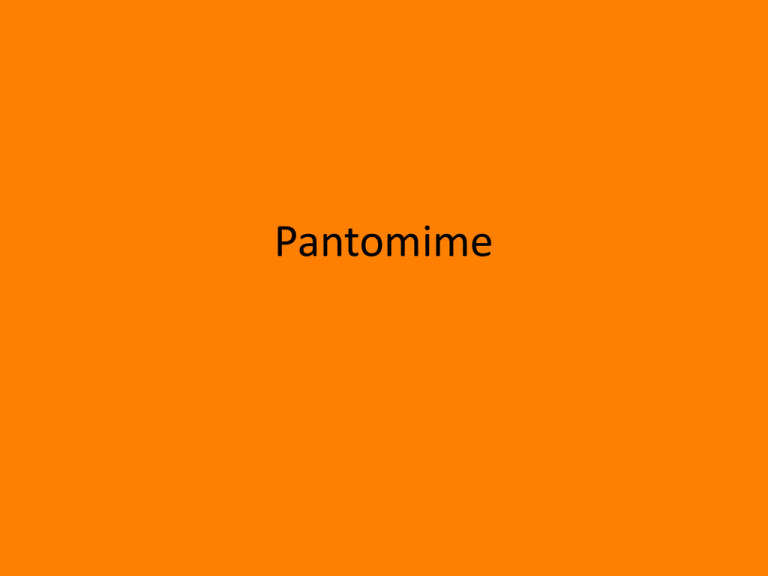
Pantomime MIME vs. PANTOMIME: Similarities • Communicate by gesturing, or acting without words • Actors portray characters and scenes through facial expressions and body language that the audience can easily understand. MIME vs. PANTOMIME: Differences • Comes from the Greek word “mimesis” which means “to imitate an activity.” – Main activity is movement and it’s content deals with complex meanings and forces of life. • Pantomime comes from the Latin word “pantomimus” which means “ all gestures used in support of a theme.” – Revolves around character and plot, using imaginary props and people to tell a story. MIME vs. PANTOMIME: Differences • Pantomime- simple, chronological story lines • Mime – complex story lines based on theme, illusion, and plot which requires a higher level of communication between the actor and audience Definitions Mime – the silent art of using body movements to create an illusion of reality Pantomime- the use of mime techniques, acting without words, to tell a story Pantomime Tips • Requires concentration on details in movements and expression • SHOW, do not tell, what is happening • Communicate clearly by using – Simplicity – Accuracy – Consistency – Exaggeration Pantomime Tips • Make actions clear and exact so that observers are never in doubt • Every movement an audience sees should be well planned and prepared (like dance choreography) Preparing a Story for Pantomime • Must be SIMPLE – Do not cloud the story with too many details • Must have 3 parts • BEGINNING: Introduction- introduces character • MIDDLE: Conflict- establishes problem • END: Resolution – solves the problem Practicing/Presenting Pantomime • Accuracy in movements make it believable and understandable • Consistency keeps all items in the pantomime the same size, shape, weight and in the same place • Exaggeration makes the actions bigger than life which helps the audience see action more clearly To achieve clarity • • • • • • Practice the following Focus, reach, take, accent, and release Focus- visualize the item Reach- approach the item Take- establish space that the item is in Accent – show size, shape, weight, temperature and any other detail that will help the audience understand what it is • Release – finish using the object and discard it appropriately. Activity #1 Character Walk • Everyone participates • Class puts ways to move across the room on the board. • Students begin walking normally around the room without touching each other • Teacher calls out a way to move and students change their movement to match Activity #2 Object Focus and Detail • Class creates a list of small objects • An item is called out and students visualize using the object. • One student from the table then acst out using the object using their visualization as a base line • Students from table evaluate the clarity of the action and make suggestions for improvement Activity #3 Where are you? • Class makes a list of places people go • 1st volunteer secretly chooses one of the places listed. • Volunteer imagines all the senses that make him/her aware of that place. • Volunteer begins acting out where s/he is • When others think they understand where the 1st volunteer is, they raise a hand volunteering to act out being in that place as well. Teacher will choose 3-4 students to join the pantomime of that place. • At the end the 1st volunteer reveals the place and the other players and audience evaluate the actions that led the other players to end up in the same place or a different place. Activity #4 How are you feeling? • • • • Table activity Class makes a list of emotions. Table establishes order of participation. 1st person secretly chooses and emotion and visualizes what it looks like when they feel this way (posture, gestures, and facial expression). Then act out the emotion. • Table attempts to guess the emotion. • Table evaluates clearer ways to show the emotion. Activity #5 Scenes for Pantomime: Procedure • Small group activity (4-5) • Group chooses a common location. (ex. park) • Group lists SIMPLE problems that could occur in that location. (ex. gum stuck to shoe) • Each person in the group selects ONE problem to pantomime in that location. Group decides performance order. Group decides on a creative title that does not give away the location. • Each person writes a detailed story line for their simple problem using SAMPLE as a guideline. MAY NOT USE OTHER STUDENTS IN THEIR STORY LINE– THIS IS SOLO. Activity #5 Scenes for Pantomime Rehearsal and Performance • Each movement in the pantomime should be planned, practiced and clear to the audience. Like making dance steps. • Students practice individually. • Students show the members of their group and group evaluates ways to improve believability and clarity. • Group practices the scene in order. • Group performs for the class. • Class tries to guess location and the problems that occurred in the location. Activity #5 CHARACTER VARIATION • Group chooses a common location. • Group makes a list of people that would be in that location. • Group makes a list of SIMPLE problems that occur in that location. Group decides on a creative title that does not give away the characters or location. • Each student chooses a different character and problem to pantomime. Each person writes a detailed story line for their simple problem using SAMPLE as a guideline. MAY NOT USE OTHER STUDENTS IN THEIR STORY LINE– THIS IS SOLO.
